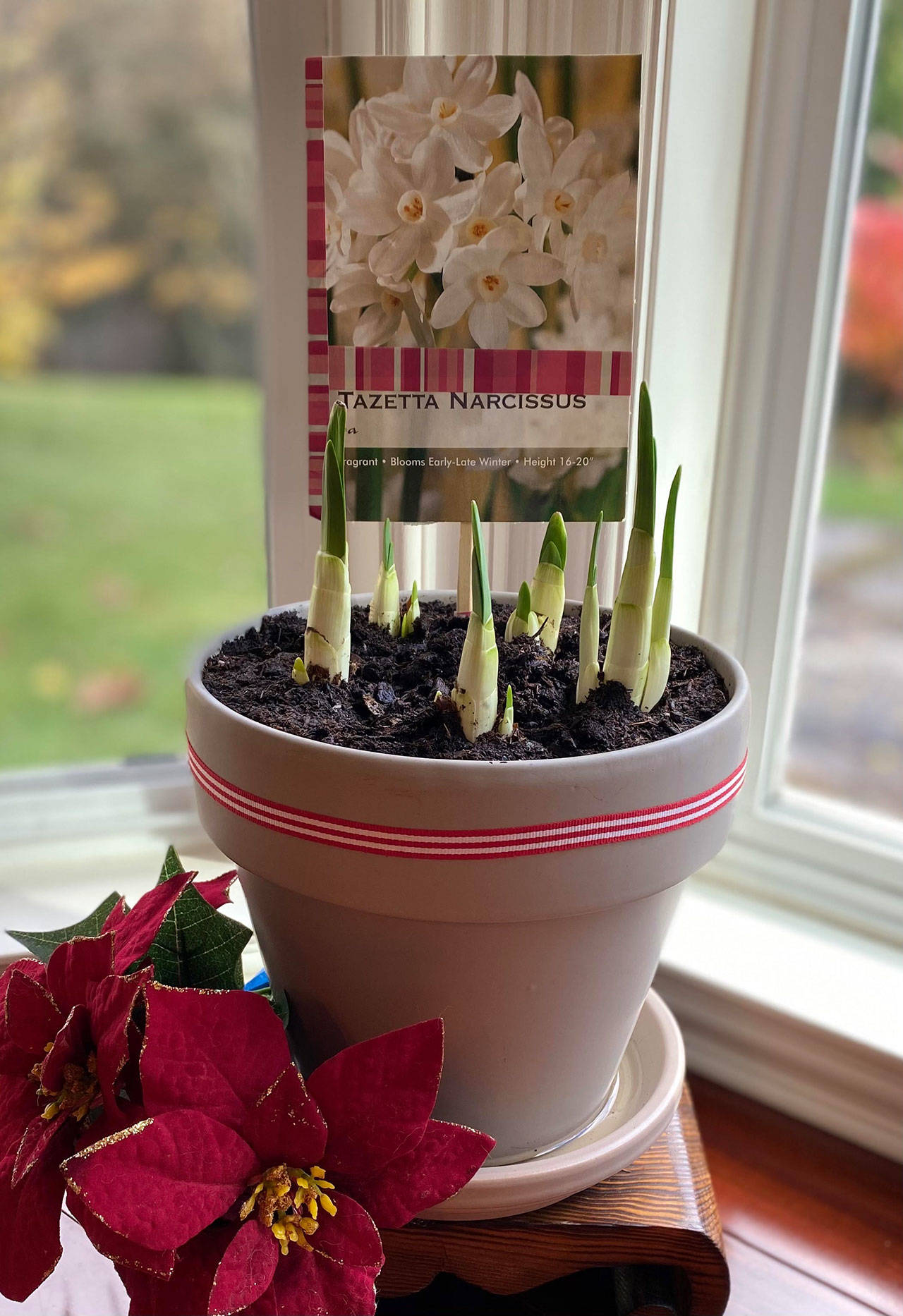A number of colorful houseplants have long been associated with the holiday season. These plants make great gifts that will brighten the homes of family and friends. But how do you select and care for these gift plants so that they provide beauty and cheer well into the New Year?
This is the first of a two-part series about the selection and care of four traditional holiday gift plants. This article will cover amaryllises and paperwhites, plants traditionally purchased as bulbs and forced to bloom indoors.
The Dec. 16 article will cover the ever popular poinsettia and Christmas cactus.
Amaryllis
The amaryllis (genus Hippeastrum) is native to tropical and subtropical regions of the Americas ranging from Argentina to Mexico and the Caribbean.
With its large trumpet-shaped flowers, the amaryllis seems to herald the holidays when it blooms. Flowers can be solid, variegated or striped, with single or double petals, in shades of white, pink and red.
The amaryllis is grown from a large bulb that must be planted 6-8 weeks before the desired blooming date. You can purchase amaryllis bulbs as part of a kit that includes a container and planting medium or separately.
Select bulbs that are firm, light greenish-white in color with a brown scaly outer layer and no signs of mold, decay or injury. Because bigger bulbs produce more flowers, buy the biggest bulb that you can.
Plant your amaryllis in a pot about 2 inches bigger in diameter than the diameter of the bulb; situate the bulb so that the top one-third to one-half is above the soil.
Water the bulb thoroughly after planting and place it in a warm, sunny spot. Do not water it again until the soil dries out or foliage appears.
In a couple of weeks a large bud (which holds multiple flowers) will emerge from the nose of the bulb; the stalk on which the bud sits will grow quickly, reaching a foot or more in height. A few leaves might also appear.
Rotate the pot daily to keep the stalk straight.
When the first blossom opens, move the plant to a cool, shaded room (about 65 degrees). The flowers will open in progression, each lasting about a week. Remove the individual flowers as they fade.
When all the flowers are spent, cut the flower stalk to two inches above the nose of the bulb and place your amaryllis in a sunny window. If it has not already, the bulb will produce leaves after the flowers have faded.
Water your amaryllis when the soil surface is nearly dry. Fertilize it every two to four weeks during the spring and summer. Amaryllises naturally bloom in the winter. With good care, your plant will survive to bloom again.
Paperwhites
Paperwhites are members of the narcissus family and originate in coastal areas of the Mediterranean, central Asia and China.
Paperwhites produce stunning clusters of daffodil-like blooms at the end of long slender stalks. They are extremely fragrant and come in delicate shades of off-white.
Paperwhites are grown from bulbs and are the original “just add water” plant. Unlike other members of the narcissus family, the bulbs do not require a chilling period to flower. All you need to do is plant them and add water; they will do the rest.
Paperwhites are usually sold as a kit that includes bulbs, planting medium and a pot. While paperwhite bulbs can be planted in soil, they do well in containers filled with stones. Here’s how you do it.
Select a container that is three to four inches deep with no drain holes.
Spread 1-2 inches of small pebbles or stones along the bottom of the container.
Place the bulbs on top of the stones with the pointed ends up.
Add stones to fill the gaps between the bulbs; the tips of the bulbs should still be showing.
Add water to the base of the bulbs, but do not submerge them.
Place your planted paperwhites in a cool, dark room until roots appear. Then move the container to a bright, sunny window. As the water disappears, add more water up to the base of the bulbs.
When the plants begin to flower, move the container to a cooler area with indirect light to extend the life of the blooms.
A common complaint about paperwhites is that they get tall and top-heavy, causing the stems to flop or bend as they begin to bloom. Placing the plants in bright sunlight early in their development will keep the stems shorter, but they still get a bit lanky.
If this bothers you, create a decorative support for the stems. A bush of twiggy branches stuck into the pot or a small homemade fence around the container will support the aging stems. Planting them in a tall glass vase with stones is another approach.
Paperwhites will not survive to re-flower, so this is one holiday gift plant to enjoy immediately and then discard!
Be aware that amaryllises and paperwhites can be toxic, if ingested; the bulbs pose the biggest threat. Keep plants and bulbs out of reach of small children and pets.
If you are thinking of purchasing or gifting amaryllis or paperwhite bulbs, do not delay. The bulbs take a bit of time to sprout and flower, so plant them now to add a happy splash to your holiday season.
Jeanette Stehr-Green is a WSU-certified Clallam County Master Gardener.


